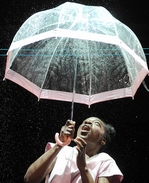SITE GUIDE
SEARCH
REVIEWS
REVIEW ARCHIVES
ADVERTISING AT CURTAINUP
FEATURES
NEWS
Etcetera and
Short Term Listings
LISTINGS
Broadway
Off-Broadway
NYC Restaurants
BOOKS and CDs
OTHER PLACES
Berkshires
London
California
New Jersey
DC
Connecticut
Philadelphia
Elsewhere
QUOTES
TKTS
PLAYWRIGHTS' ALBUMS
LETTERS TO EDITOR
FILM
LINKS
MISCELLANEOUS
Free Updates
Masthead
Writing for Us
A CurtainUp  London Review
London Review
 London Review
London ReviewEurydice
|
A wedding is for daughters and fathers. The mothers all dress up, trying to look like young women. But a wedding is for a father and a daughter. They stop being married to each other on that day. — Eurydice
|

Ony Uhiara as Eurydice (Photo: Alastair Muir) |
Bijan Sheibani is one of the most exciting directors of physical theatre we have in the UK and it is with heightened anticipation that we view his productions. But somehow there seems to me to have been a mismatch here. Ruhl's text fails to reach its full poetic potential in the round staging in the Maria Studio at the Young Vic. It isn't because of the nuanced performance from Ony Uhiara as the bookish Eurydice, nor Osi Okerafor's beautiful singing voice as Orpheus of which we hear too little. The problem seems to be with the Three Stones whose malevolent and predatory, choric pacing around denies the nothingness that is meant to be the state of the stones, a reference to the effect of Orpheus' music in the Keats' poem, "In sorrow I sing a sad song/That makes stones weep."
The forgetfulness that is experienced as they travel through the river Styx means that Eurydice does not know where she is when she arrives in the Underworld. So we have a curious surreal experience as she thinks she is staying in an hotel and asks for her room, treating her father as the hotel porter. Her father, who kept his memory by holding his breath when he was dipped in the river, takes some string and fashions her a room. The production uses water and the imagery of water to good effect: sometimes bubbling up from the floor, sometimes raining down in the elevator, or at the wedding riding up like those spontaneous fountains that take passers-by unawares. The lighting is effective too, those square frames of liquid light used above the playing area.
This Eurydice is a dreamlike production with quirky, oddball moments of humour as when the Lord of the Underworld rides in on his tricycle wearing the loudest of striped suits. There are unforgettable visual images too: the strobe lit wedding dance with a high kicking jitterbug dance, the strobe being used to disguise the change to Eurydice's clothes, out of her wedding dress. I found the 1950s beach scene, the first where Orpheus and Eurydice declare undying love, stylised and more like a television advertisement dreamt up by Mad Men than the prelude to a Greek myth. The more prosaic images contrast with the beauty of the speech. We hear that Orpheus can hold twelve melodies at once and that he is going to make each strand of Eurydice's hair into an instrument. I was also curious to know why American accents were chosen for the English speaking cast.
I definitely would like to see more of Sarah Ruhl's writing although it undoubtedly will challenge directors. For more details of the play and a review of its production at New York's Second stage, go here.
|
Subscribe to our FREE email updates with a note from editor Elyse Sommer about additions to the website -- with main page hot links to the latest features posted at our numerous locations. To subscribe,
E-mail: esommer@curtainup.comesommer@curtainup.com
put SUBSCRIBE CURTAINUP EMAIL UPDATE in the subject line and your full name and email address in the body of the message -- if you can spare a minute, tell us how you came to CurtainUp and from what part of the country. |
| Eurydice
Written by Sarah Ruhl Directed by Bijan Sheibani Starring: Ony Uhiara, Geff Francis, Osi Okerafor With: Marsha Henry, Becci Gemmell, Ben Addis, Rhys Rusbatch Design: Patrick Burnier Lighting: Mike Gunning Music and Sound: Manuel Pinheiro Choreographer: Aline David Running time: One hour 40 minutes with no interval Box Office: 020 7922 2922 Booking to 5th June 2010 Reviewed by Lizzie Loveridge based on 5th May 2010 performance at the Young Vic, The Cut, London SE1 8LZ (Rail/Tube: Waterloo or Southwark) |
|
REVIEW FEEDBACK Highlight one of the responses below and click "copy" or"CTRL+C"
Paste the highlighted text into the subject line (CTRL+ V): Feel free to add detailed comments in the body of the email . . . also the names and emails of any friends to whom you'd like us to forward a copy of this review. |
|
London Theatre Tickets Lion King Tickets Billy Elliot Tickets Mighty Boosh Tickets Mamma Mia Tickets We Will Rock You Tickets Theatre Tickets |




